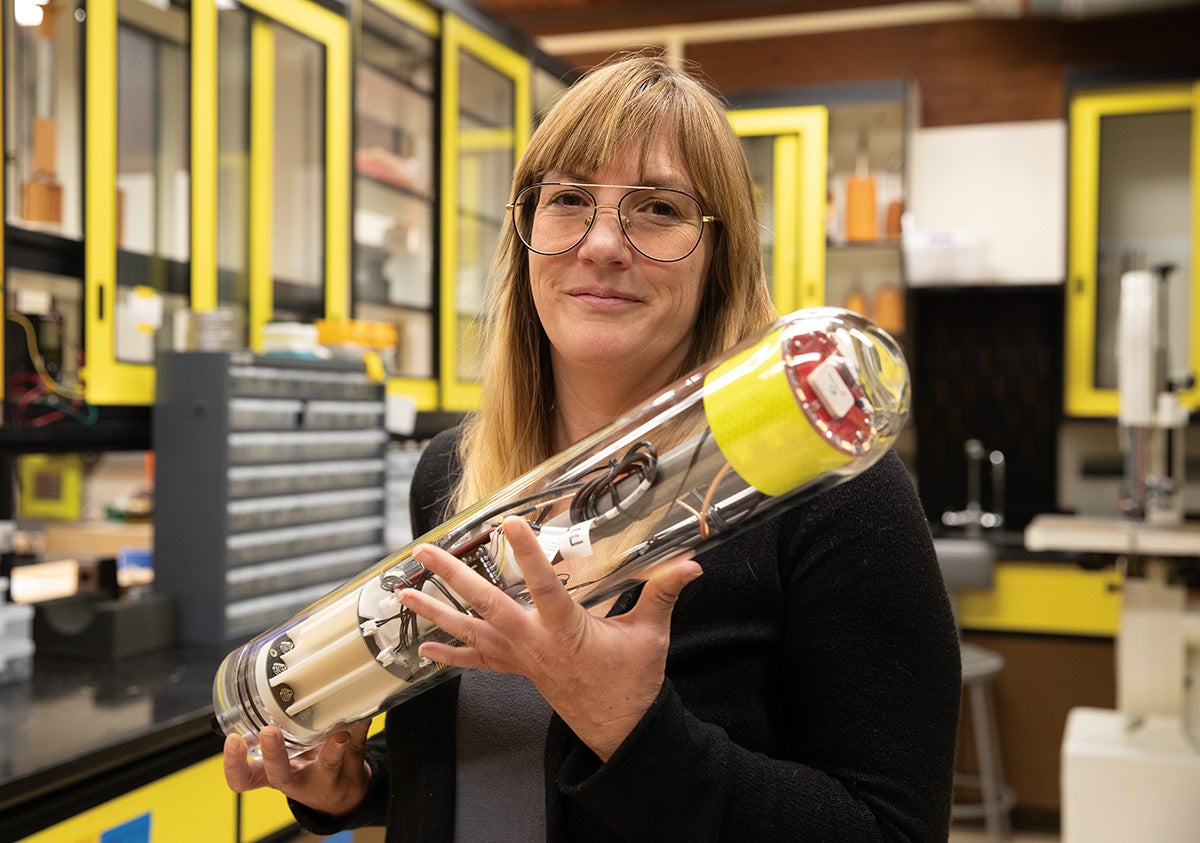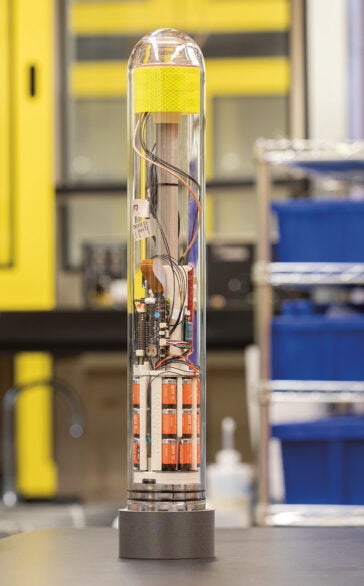The revelatory moment came for Melissa Omand when she, a physical oceanographer by training, saw her husband, Ben, struggling to develop an ocean sensor instrument without using plastics, expending effort for a device and racking up costs as he tested alternative materials.
“And the instruments were pretty much a failure,” she recalls. “It is so painful when you’re on a research vessel and these tools don’t work the way you expect.”
Omand, associate professor of oceanography at the University of Rhode Island, knew there was a better way to design and construct marine tools that would not contribute to the pollution of water bodies they were made to measure. MINION floats, glass tubes containing sensors to measure the flow of carbon throughout the ocean’s water columns.
Plastic Problems
According to the United Nations Educational, Scientific and Cultural Organization (UNESCO), eight to 10 million tons of plastic each year end up in the world’s oceans. By 2050, the oceans will contain more pieces of plastic than fish in the seas.
Additionally, most research examines how plastics collect and pollute the sea surface. Little is known about their impact on the deep ocean, and standards (set by organizations like the American Society of Safety Professionals) for measuring degradation rates do not account for their breaking down in cold, dark environments.

“All of the focus for measuring degradation is set at 20 degrees Celsius in shallow water environments, but 99 percent of the ocean is deep and cold,” says Omand.
The big question for Omand is: Can we design a biomaterial purpose-built for ocean degradation and make it available for anyone using marine tools, from oyster aquaculturalists and fishermen to oceanographers like herself deploying a myriad of expendable sensors across the world? The answer became clearer in 2019 when Omand met Alyson Santoro, a marine biologist at the University of California-Santa Barbara.
“We had a conversation about how to make floats I was designing more sustainable, and she suggested that maybe we could add microbes or other naturally occurring compounds like nutrients that would break them down,” she explains.
The big question for Omand is: Can we design a biomaterial purpose-built for ocean degradation and make it available for anyone using marine tools?
Unfortunately for Omand, an important component of her MINION floats was made out of polylactic acid (PLA), a polymer found in almost any biodegradable plastic. PLA breaks down in only highly controlled waste facilities where temperatures reach 55 degrees Celsius and specific microbes are deployed to decompose the polymer. No marine environment, says Omand, can match those conditions.
Enter PHB, or polyhydroxybutyrate, a polymer that many bacteria already produce as an intracellular food reserve. Some microbes, known as methanotrophs, munch on methane and have been found in abundance throughout the world’s oceans: the same methane that is often trapped in ocean sediments and potentially released as the climate warms. If instruments like drifters could be made out of PHB, theorized Omand and Santoro, then maybe a biodegradable option was possible after all.
Researchers, Assemble!

Through the National Science Foundation’s (NSF) Convergence Accelerator Program, Omand and Santoro formed Nereid Biomaterials to test PHBs as a biodegradable material for marine applications. They teamed up with Mango Materials, a California-based company already established in creating biodegradable plastics, to provide pellets for experimentation and design.
To ensure that an instrument made of PHB would break down in any marine environment, the group then brought on Anne Meyer, a synthetic biologist at the University of Rochester. The idea? Develop a way to adhere or blend living bacteria and non-living nutrients and enzymes into the biodegradable compound.
“By compounding the plastic with these living cells and other naturally-occurring additives, we can help the material be really, really delicious for specific ocean microbes,” says Omand. “This work is still experimental, but if PHB is the grains, then these additives are the fruits and vegetables keeping the bacteria healthy to break down the plastic.”
Omand’s main focus on the project, however, is to design and prototype end products made of PHB that members of ocean industries will use. She has long been a proponent of developing low-cost ocean instruments that can be deployed without harm to marine environments and then never seen again, which saves on fuel and other costs that research cruises expend to retrieve expensive, highly complex instruments. Her MINION floats, glass tubes containing sensors to measure the flow of carbon throughout the ocean’s water columns, offer a perfect example.
Omand likens her position to that of a chief technology officer, deploying 3D printed test instruments such as eel trap doors. She also has PHB-made products in the shape of discs and “dog bones” placed in bottles at locations throughout Narragansett Bay, as well as in the Olympic National Marine Sanctuary in Washington State and in shallow and deep waters off Santa Barbara, CA.
“It is not enough to just introduce the PHB material like pellets into the market and expect manufacturers to pick it up. We need to have physical examples of these end products.”
Entrepreneurial Spirit
Omand admits one of the greatest challenges in doing this work is not the designing of ocean instruments, but entering the world of entrepreneurs who use terms like “market fit” and “minimal viable product.” As part of the NSF Convergence Accelerator, Omand and her colleagues must engage with potential end-product users, identify their needs and how PHB-based plastics can make their businesses more profitable.
“More than anything I would love to actually have viable gear for fishing and ecosystem restoration. I will still be making low-cost, expendable ocean instrumentation, but it is so important for me to know that it’s ocean degradable.”Melissa Omand
“Our homework was to work with coaches who helped us interview people in different sectors, creating full perspectives on what their pain points are and how products we make could be useful,” says Omand. “We aren’t necessarily meant to publish a paper at the end of it but find sustainable market potential. The experience helped us recognize the first ideas that we needed to pivot away from.
“I never imagined that I would end up learning about the mechanics of starting a business, but without the coaching, I don’t think we would have been able to get through it as academics are extremely busy.”
Drifting Future
The $4.9 million grant funding the work of Omand and her colleagues through Nereid Biomaterials is scheduled to end in August 2024. The URI oceanographer is hopeful that some of their end products transition into commercially viable instruments for industries such as commercial fishing, but the ideas and research they’ve compiled is more than enough to pursue other funding avenues when the grant concludes.
What’s more, Omand says she is proud of the interns who have worked alongside the Nereid Biomaterials team and gone on to work in positions related to biodegradable plastics, particularly at Mango Materials.
The more companies creating marine research and other ocean-related equipment out of biodegradable plastics, the better, she says.
“More than anything I would love to actually have viable gear for fishing and ecosystem restoration. I will still be making low-cost, expendable ocean instrumentation, but it is so important for me to know that it’s ocean degradable.”
